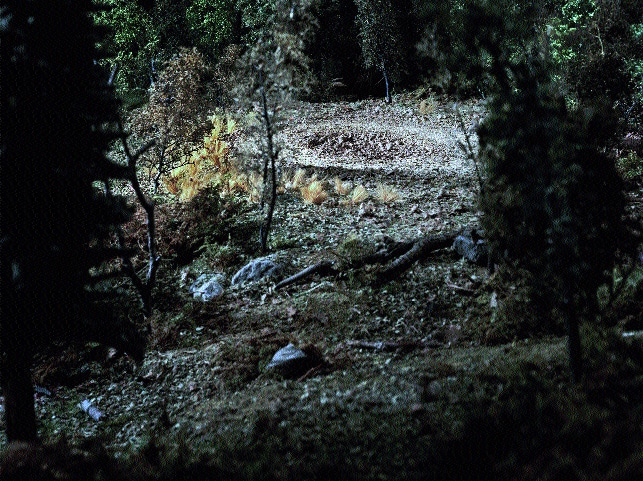Bill Finger
Paramnesia
Paramnesia is defined as the “distortion of memory in which fantasy and objective experience are confused.” It is literally a mental collision of fact and fiction that becomes in essence a new personal truth. Unless someone exhibits absolute recall, it is my belief that all memories with time become a form of paramnesia.
In working to create this body of images, I attempt to re-create places and landscapes from my own past. In doing so, I could create the ultimate referent or key for memory – a photograph of that time and place. In working with the idea of the photograph as memory object, I chose for the creation of these landscapes the use of constructed miniatures. The miniature like the photograph has long held a part as a souvenir of places visited. Additionally, the miniature has a history within museums to present past events or historical overviews. Lastly, there is a connection to childhood fantasy and imagination with objects reproduced in miniature form. Therefore, to create these photographs I had to first create a miniature landscape, which would personally reference a particular place and time. Once the miniature was completed, I could then make my photograph. This photograph would serve as a souvenir of the past via the present.
In re-creating these landscapes from my memory, I soon realized that I would have to admit to a certain degree of paramnesia. To remember, you key into certain elements that serve as triggers for certain memories. Therefore, if anything my re-creation of these places brought me closer to the time and place in generel but at the same time filled me with a certain amount of doubt as to the veracity of the specifics. In this sense, memory can be similar to photographs in that they only show or reveal a very limited view. Everything that is outside of the borders or existed between images must be reconstructed by the minds of the participants. In my case, by filling in this missing information or detail, I have to consider how much of it is colored by the lens of who I am now as a person. For instance in re-creating a moment from childhood, I am obviously a very different person now than when I was eight years old. Therefore, memories are constantly re-adjusting based Lipan life experiances and personal context. So, the more that I create the more they become jumping off points to destinations that I am not sure truly existed.
Coming to doubt my own memories, I began to embrace the paramensia that was occurring in the photographs. I began to work as one does when remembering a story or event from the past where the key points are embellished with each telling. Paramnesia for this project became a combination of fact and storytelling fiction. Each image asserts and embraces a point of view. Therefore, I became very conscious of the point of view that I present to the viewer in creating each photograph. Point of view both metaphorically and visually is very important to each image. It is only through inserting the viewer into the scene that I am remembering that I can propel the past forward. It is a momentum forward that is derived very heavily from cinema. This is another example of my own present influencing my remembrance of the past for I currently work within the motion picture industry.
In creating these images, I have discovered that all memories including the photographs that signify them are malleable. Time, context and point of view are forever shifting and because of this, we are always constructing and reconstructing our images as well as our own histories.
Bill Finger
/notes/
- Paramnesia is the title for this body of work that was recently exhibited at the George Eastman House Museum of Photography and Film in Rochester, New York (US).
- My work is elso included in the permanent collection there.
- All images were created using a largo format view camera. Angle of view is very important and all miniature work is specifically designed to that angle of view. I light each miniature landscape with hot lights instead of strobes. Both designing an image to and through the lens, and the use of hot lights are a comfortable way of working which I adoptod from my film industry experience. Though I do scan my images into Photoshop, I do not manipulate the photograph beyond slight color corrections. The computer also facilitates my printing to larger scales than I was oble to with traditional calor darkroom equipment Each image takes from one to three months to complete. Images vary in scale from 60x50cm to 152x101cm.
- www.finger0101.com
#8 Landscape
Archive
- #45 hypertension
- #44 empathy
- #43 collecting
- #42 food
- #41 postdigital photography
- #40 earthlings
- #39 delight, pain
- #38 death, when you think about it
- #37 uneven ground
- #36 new utopias
- #35 living with humans
- #34 archaeology of euphoria
- #33 investigation
- #32 Non-work
- #31 Body
- #30 Eye In The Sky
- #29 Contemplation
- #28 Cultura / Natura
- #27 Cars
- #26 Documentary Strategies
- #25 Popular Music
- #24 Seeing Is Believing
- #23 Artificial Worlds
- #22 Image and Text
- #21 On Photography
- #20 Public Art
- #19 Film
- #18 80'
- #17 Amateur Photography
- #16 Photography and Painting
- #15 Prague
- #14 Commerce
- #13 Family
- #12 Reconstruction
- #11 Performance
- #10 Eroticon
- #9 Architecture
- #8 Landscape
- #7 New Staged Photography
- #6 The Recycle Image
- #5 Borders Of Documentary
- #4 Intimacy
- #3 Transforming Of Symbol
- #2 Collective Authorship
- #1 Face





